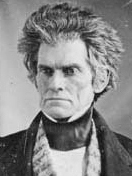READ: States' Rights Lead to Secession
States' Rights
THE RALLYING CRY OF SECESSION
The appeal to states' rights is of the most potent symbols of the American Civil War, but confusion abounds as to the historical and present meaning of this federalist principle.

South Carolinians crowd into the streets of Charleston in 1860 to hear speeches promoting secession.
The concept of states' rights had been an old idea by 1860. The original thirteen colonies in America in the 1700s, separated from the mother country in Europe by a vast ocean, were use to making many of their own decisions and ignoring quite a few of the rules imposed on them from abroad. During the American Revolution, the founding fathers were forced to compromise with the states to ensure ratification of the Constitution and the establishment of a united country. In fact, the original Constitution banned slavery, but Virginia would not accept it; and Massachusetts would not ratify the document without a Bill of Rights.
The debate over which powers rightly belonged to the states and which to the Federal Government became heated again in the 1820s and 1830s fueled by the divisive issue of whether slavery would be allowed in the new territories forming as the nation expanded westward.
The South
- Southerners consistently argued for states rights and a weak federal government but it was not until the 1850s that they raised the issue of secession.
- Southerners argued that, having ratified the Constitution and having agreed to join the new nation in the late 1780s, they retained the power to cancel the agreement and they threatened to do just that unless, as South Carolinian John C. Calhoun put it, the Senate passed a constitutional amendment to give back to the South “the power she possessed of protecting herself before the equilibrium of the two sections was destroyed.”
 John Calhoun
John Calhoun